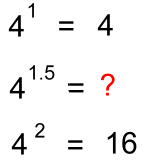 Exponents can be fractions or decimals, as in 53/2, 27-2/3 or 100.2. We'll look at what these rational exponents mean, and how to evaluate them.  Consider the powers at the left.
Consider the powers at the left. We know what it means to multiply 4 once ... it's 4. Similarly we know that 4 multiplied by itself, or 42, is 16. But what does in mean to multiply 4 by itself 'one and a half' times? Let's look at a simpler example first. What is the value of 40.5 or 41/2 ? Here's the answer:  A fractional exponent is equivalent to a radical. In particular, when the fraction has numerator '1 ': In words: 'A power of x with an exponent 1 over n is the same as the nth root of x' In symbols:  Here are a few examples:   This one could be evaluated This one could be evaluated If the exponent is negative, do that first If the exponent is negative, do that first
Now let's look at fractional exponents where the numerator isn't one. Go on to page two ... |